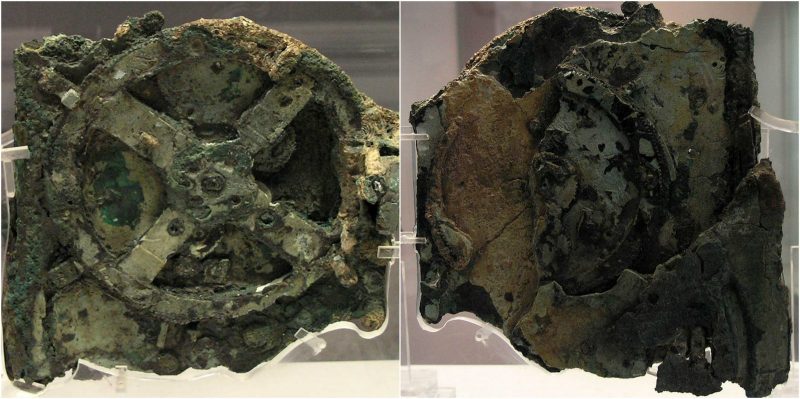Found in 148 feet of water, in the Antikythera shipwreck, off the Point of Glyphadia on the Greek island of Antikythera, is the Antikythera mechanism.
A group of Greek sponge divers found the mechanism in April 1900. They also found a host of other artifacts, including jewelry, pottery, glassware, bronze and marble statues, and coins.
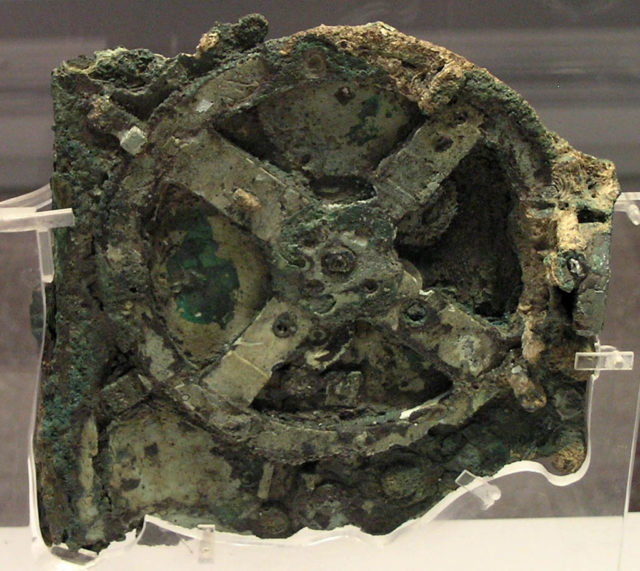
All the artifacts were taken to the National Museum of Archaeology in Athens for analysis and storage. Unconcerned with the large lump of corroded bronze and wood, the mechanism went unnoticed for two years while the staff worked on the more obvious statues.
Any further investigations into the object were soon put aside until British science historian and Yale University professor, Derek J. Solla Price became interested in the artifact in 1951. 20 years later, Price and Greek nuclear physicist, Charalampos Karakalos made x-ray and gamma-ray images of the 82 pieces. In 1974, Price published their findings in a 70-page paper.Archaeologist, Valerios Stais, was looking at all the finds and noticed that the large piece of rock had what looked to be a gear wheel stuck in it. Originally, he thought it was an astrological clock, but most scholars believed the clock to be prochronistic, or too complex to have been made during the same era as the other pieces that were recovered.
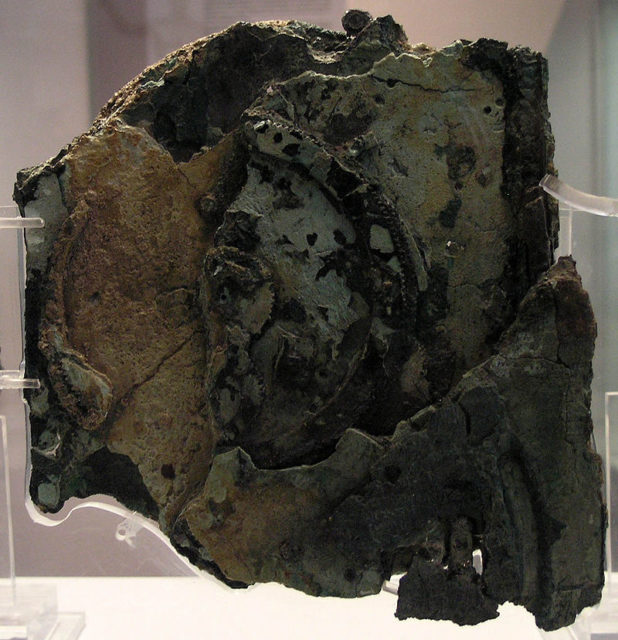
Nobody knows how the mechanism got on the cargo ship, but it has been suggested that it was being taken to Rome, along with the other pieces looted from the Greek island, to aide in a parade being held for Julius Caesar.
Normally called the first known analog computer, the mechanism has qualities that suggests that it may have predecessors that have been undiscovered that mere made during the Hellenistic period. Developed by Greek astronomers, the mechanisms’ construction relied upon theories of astronomy and mathematics, and it is estimated to have been made around the late second century BC.
Price, in 1974, after studying the mechanism, stated that the gear settings and inscriptions on the face of the mechanism, that is was manufactured about 87 BC and lost at sea a few years later. In 1976, Jacques Cousteau and his team went to the site where the mechanism and the other artifacts were found, and they recovered coins dated between 79 and 67 BC.
Researchers believe that the mechanism was made from low-tin bronze alloy (approximately 95% copper, 5% tin), but in its advanced state of corrosion, it has been impossible to do any accurate compositional analysis of the item. All the instructions on the mechanism are written in Koine Greek, and the general agreement among the scholars is that the mechanism was made in the Greek speaking world.
Sometime in the late 2000s, findings of The Antikythera Mechanism Research Project suggest that the concept for the mechanism started in the colonies of Corinth, because some of the astronomical calculations indicate observations that can be made only in the Corinth area of Ancient Greece.
One theory suggests, that Syracuse, which was a colony of Corinth, and the home of Archimedes, might have a connection with the school of Archimedes. And the coins that Jacques Cousteau found at the wreck site in the 1970s, date to the time of the mechanism’s construction, which suggests that its origin may have been from the ancient Greek city of Pergamon, home of the Library of Pergamum.
The Library of Pergamum, with its scrolls of art and science, was second in importance only to the Library of Alexandria during the Hellenistic period.
There were also vases on the cargo ship that was carrying the mechanism. The vases are in the Rhodian style, leading to the theory that the mechanism was made at an academy founded by the Stoic philosopher Posidonus on the Greek island of Rhodes. Rhodes was a bustling trading port in antiquity, but it was also the center for mechanical engineering and astronomy, home to Hipparchus, the astronomer that was active from 140 BC to 120 BC.
Since the mechanism uses Hipparchus’s theory for the motion of the moon suggests that he might have designed, or at least worked on it.
Michael Edmunds, a Cardiff University professor, that led a 2006 study of the mechanism, stated that the device was “just extraordinary, the only thing of its kind”, he also said that its astronomy was “exactly right”. He is the person who said that the Antikythera mechanism was “more valuable than the Mona Lisa”.
After several years of studying the mechanism and Babylonian records of eclipses, Christian Carman and James Evans pinpointed the date that the mechanism was set to begin-205 BC. This date suggests that the mechanism is 50-100 years older than originally thought.
Speculatively, this timing also make an old story told by Cicero more likely-that a similar mechanism was created by Archimedes and taken back Rome by the Roman general Marcellus, after the attack and looting of Syracuse and the death of Archimedes in 212 BC.
Carman and Evans came to the 205 BC date using a method of elimination that they came up with. Starting with hundreds of ways that the mechanism’s eclipse patterns could fit Babylonian records (as reconstructed by John Steele, Brown University) the team used their system to eliminate dates successively, until they had a single possibility.
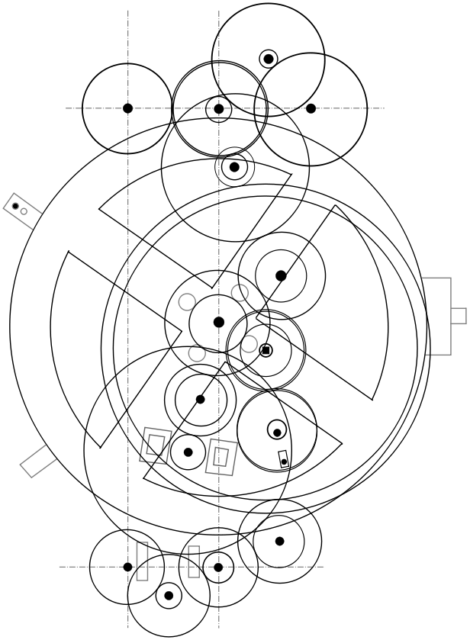
The calculations consider lunar and solar anomalies, missing solar eclipses, lunar and solar eclipse cycles, and other astronomical phenomena. There is only about one-third of the mechanisms’ eclipse predictor preserved, so the work was very difficult.
There is a fixed ring on the front face of the dial, representing the ecliptic, the twelve zodiacal signs marked off with equal 30-degree sectors.
This matched up with the Babylonian custom of assigning one twelfth of the ecliptic to each zodiac sign equally, even though you have the variable of the constellation boundaries. On the outside of the first dial is another ring which is rotatable. It is marked off with the months and days of the Sothic Egyptian calendar, 12 months of 30 days plus five intercalary days.
Each month is marked with the Egyptian name transcribed into the Greek alphabet. First, is to rotate the Egyptian calendar ring to match the current zodiac points. The Egyptians ignored leap year days, so it advanced through a full zodiac sign in about 120 years.
To operate the mechanism, you had to turn a small hand crank (now lost) that was linked to a crown gear into the largest gear, the four-spoked gear on the front of fragment A, the gear named b1. This then moved the date pointer on the front dial, that would set the correct Egyptian day.
You can’t select the year, so you must know the current year that is set, or by looking up the cycles shown by the various calendar cycle indicators on the back in the Babylonian almanac tables for the day of the current year set, since most of the calendar cycles are not concurrent with the year. In a full rotation, the crank moves the date pointer about 78 days, so getting to a specific day on the dial would be done easily if the mechanism were in good working condition.
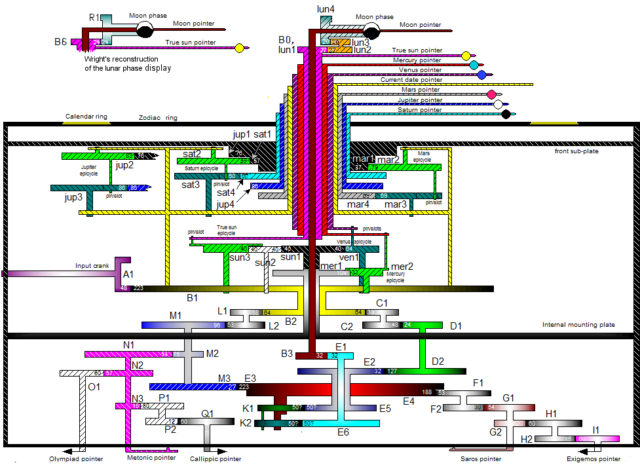
By turning the hand crank, it would also cause the interlocked gears within the mechanism to rotate, resulting in the simultaneous calculation of the position of the Sun and Moon, the moon phase, eclipse, and calendar cycles, and maybe the position of the planets.
The person who was turning the crank, also had to be aware of the position of the dial pointers on the two large disks on the back. That pointer had a “follower” that tracked the spiral cuts in the metal as the dials included four and five full rotations of the pointers. When the pointer reached the final month location at either end of the spiral, the pointer’s follower had to be manually moved to the other end of the spiral before going any further.
